Beyond blogging | Archive of Affinities
beyond blogging | davide tommaso ferrando giovanni benedetti
This post belongs to a series of interviews aimed at investigating the ideas that stand behind a selection of editorial projects dedicated to architecture and based on an experimental use of social networks such as Tumblr, Facebook and Instagram. As summarized by the title of this cycle, “beyond blogging”, we believe that the critical use of social tools is leading architectural communication to a new and promising fronteer: one in which the specific features of digital media – fast reading, relevance of the image, easiness of association, informality, viral propagation, etc. – are successfully capitalized to create inspiring architectural archives organized around specific topics, which can efficiently provide useful references for design and research tasks. Even more interestingly, the greatest part of what is published in these “one-man-webzines” is not produced by their editors (who therefore have little or no direct interest in the diffusion of their posts), but is rather the result of independent and unpaid investigations, autonomously conduced on both paper and digital sources. From this point of view, these editorial projects have the great merit of being constantly enriching the web with diverse and previously unpublished architectural references, coming from both the present and the far-away past. Their aim, therefore, is not to keep their readers updated, but to produce a connotative kind of architectural knowledge: one in which it is not the single images that count, but the relations that can be established among them. Our third interviewee is Andrew Kovacs, editor of Archive of Affinities. DTF & GB
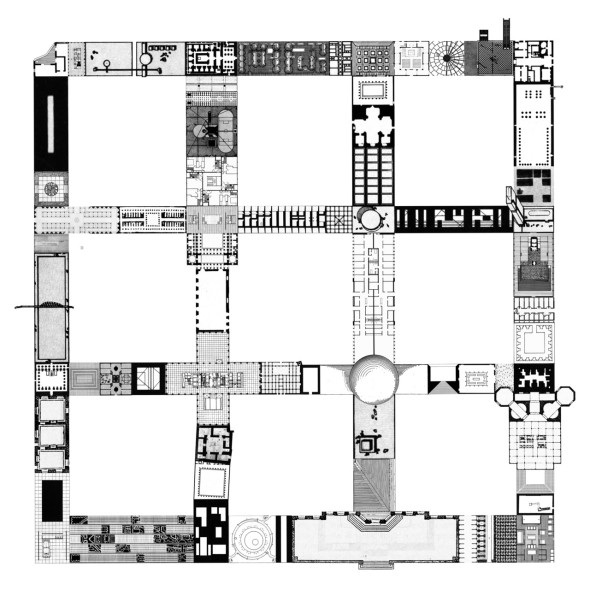 Fig. 1 Plan for a 9 square grid
Fig. 1 Plan for a 9 square grid
Site: Archive of Affinities
Platform: Tumblr
Editor: Andrew Kovacs
I. Personal info
Can you introduce yourself? (how old are you? What did you study? What did/do you do?)
My name is Andrew Kovacs. I am 30 years old and I was born in Chicago, Illinois but I now live in LA. I teach in the Architecture and Urban Design program at UCLA. I have a small architecture studio and I produce Archive of Affinities. I studied architecture at Syracuse University (B. Arch), the Architecture Association, and Princeton University (M. Arch).
Can you explain in what does your editorial activity consist?
I search and seek out architectural projects and realized buildings that are discards, anomalies, oddities and mishaps. Effectively, I am looking for projects that exist on the sidelines of the discipline of architecture. My ambition is to collapse the distance between the center and the periphery of the discipline of architecture. Rather than narrowing the discipline of architecture through an exclusive collection of work, my ambition is a collection of work that is much more inclusive with the goal to expand the limits of the discipline of architecture.
How long have you been dedicating yourself to your editorial activity?
I started Archive of Affinities in the fall of 2010 as an architecture graduate student at Princeton University. I started Archive of Affinities out of a few concerns. One was a simple curiosity – I wanted to understand what constitutes the discipline of architecture. Architects seem to always talk about the discipline of architecture but it seems rather difficult to point to where the discipline of architecture exists. The second concern was that I was unable to find the work of certain architects that I was interested in online. The third was a suspicion that many of the projects I saw being published around me that claimed to be “new” were actually copies, or rather bad copies of projects that had already existed somewhere in the history of architecture.
Does your editorial activity have effects on your profession?
My work and the production of Archive of Affinities are closely linked together where both research and production feed into each other. At times I will deliberately search out architectural works that pertain to a project I am working on. At other times architectural works that I come across by chance while sifting through history’s trash can will spark or influence a new project.
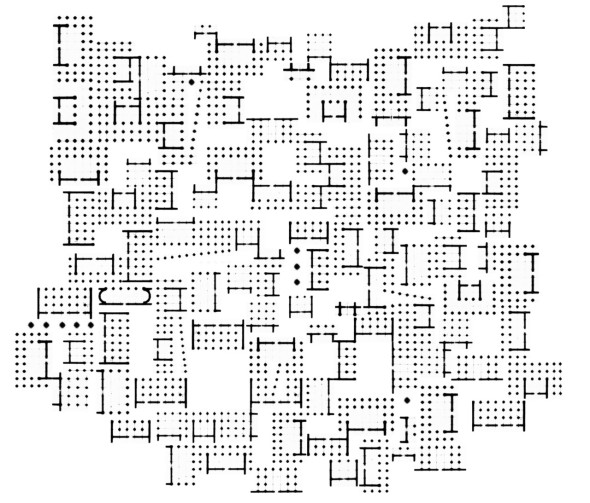 Fig. 2 Plan for a porch 005 (Homage to Durand)
Fig. 2 Plan for a porch 005 (Homage to Durand)
II. Work method
How much time do you dedicate, on average, to your editorial activity?
Because Archive of Affinities influences my architectural work and my architectural work influences Archive of Affinities, it would be difficult for me to put an exact amount of time to the production of Archive of Affinities.
Where and how do you look for the material you publish?
I go through books, journals, magazines, pamphlets and exhibition catalogs, etc. and search for things that are wonderful. At this moment in time I have posted around 3,000 images.
Have you developed and consolidated some personal publishing tehcnique?
Archive of Affinities is curated, but curated on the fly almost as a kind of speed curating. From a recent batch of “acquisitions”, I scan the images and I aggregate them by loose affiliations, formal alliances, fortuitous pairings, strange marriages and odd similarities. For me, the speed allows for a much more nimble and malleable form of display, one which ultimately provokes new readings and alternative portrayals of overlooked works of architecture.
Do you comment what you publish?
I do not comment on what I publish. For me the “comment” is the larger collection and aggregation of Archive of Affinities rather than each individual project. The whole is greater than the parts, even though the whole of Archive of Affinities is constantly growing and evolving.
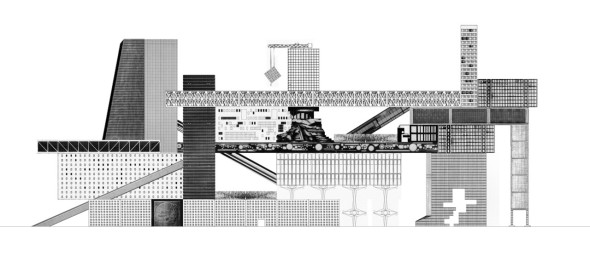 Fig. 3 Elevation for a slab
Fig. 3 Elevation for a slab
III. Theory
What is the reason that makes you publish?
I am interested in projects that exist on the periphery of the discipline of architecture. In other words, the architectural b-side. For me the architectural b-side exists on the edge of the discipline and because of this positioning it is the moment where the discipline of architecture can expand or contract and ultimately move forward. Archive of Affinities is a collection of architectural b-sides that proposes a set of architectural work that runs parallel to the canon of architecture as an alternative to the canon of architecture. Canons by their very nature are exclusive and often times can lead to a narrowing of a discourse. The goal of Archive of Affinities is to be inclusive of architectural work from the past that are useless and have been neglected with an aim to widen the discourse about architecture. As architects, we need to confront the useless projects that have piled up in our disciplinary closet. We need to take these disciplinary skeletons out of the closet and reorganize them with a fresh outlook.
Who do you want to communicate with, when you publish?
I would like to communicate with architects, people interested in architecture and ultimately the wider public. The discipline of architecture is a broad endeavor rather than a narrow one. Our field can have a powerful impact in shaping our world at all scales and sizes. I want to communicate that the built world that we inhabit does not need to be boring or banal and that as architects and really, as people, we can change, design and control the space we inhabit rather than being controlled by the space around us.
What value do you give to the likes/retweets you receive?
Although I am conscious of of the likes that Archive of Affinities receives, I am rather indifferent of them. I am more interested in the entire collection and whole of Archive of Affinities rather than individual projects.
Did you discover/learn something, while developing your editorial activity?
Through sifting, sorting, collecting and selecting thousands of images I have not only developed, but refined my own personal tastes and sensibilities. The more images I look at – good, bad, or ugly – the more I learn. Archive of Affinities is a tool for me to think through and develop my own architectural ideas.
Do you care that what you publish can influence the architects that follow you?
Yes, of course. My goal is to expand the field of architecture and widen its visibility to the greater public.
Do you think that social networks can change the way in which we design?
Absolutely. Social networks have certainly increased the speed in which we communicate about architecture and design. Yet, I think the actual influence of these networks on design and the production of architecture itself has not moved beyond that of traditional means of publishing such as magazines. The field of architecture at the end of the day is conservative and lethargic and often reluctant to easily accept change.
What is your point of view on the actual state of paper architecture magazines?
I spend a lot of time reading architecture magazines from the past. I think that many of the current magazines all have the same commodified content with a lack of direction and purpose, other than showing off the latest and greatest of shiny banality and glossy mediocrity.
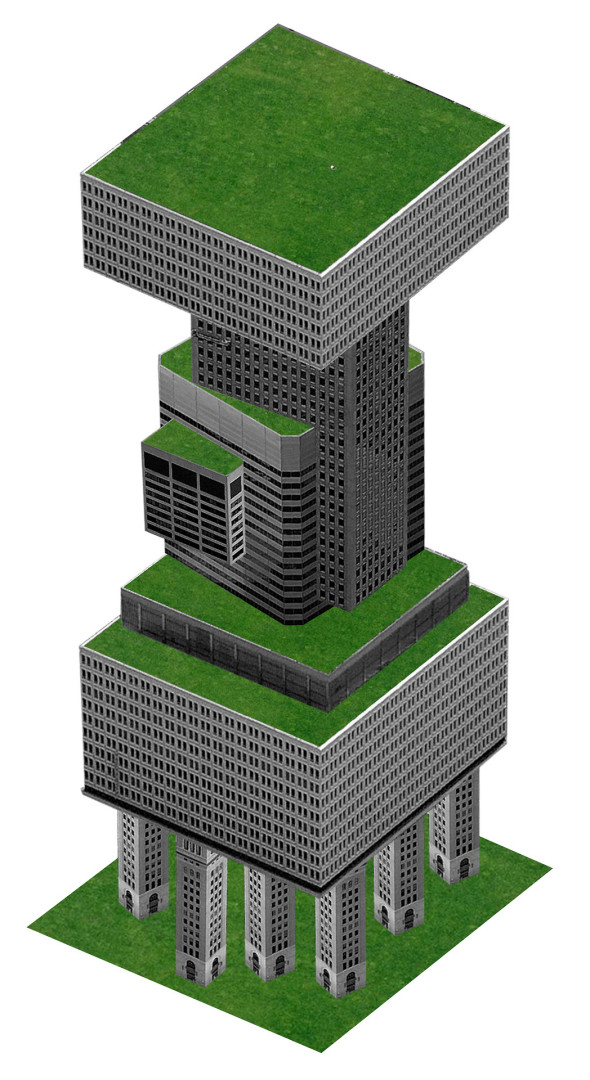 Fig. 4 Proposal for an office building
Fig. 4 Proposal for an office building
IV. References
What are your main paper sources of information, regarding architecture?
I think of the current print architectural sources, the ones I find the most interesting are Project Journal, Clog, San Rocco, Mas Context, and Pidgin.
What are your main web sources of information, regarding architecture?
Some blogs that I appreciate are: Fuck Yeah Brutalism; Architecture of Doom; Cloudz Watching; Subtilitas; The Charnel House; AQQ Index; Archi/Maps; Ugly Belgian Houses; RNDRD; dpr-barcelona; SOCKS; Ryan Panos.
Can you indicate the names of one or more actual architects that particularly interest you?
I am interested in architects that question what architecture is and what architecture can be, whether consciously or not. There is a flat hierarchy to the architects that influence me. I think that I can learn from all architects.
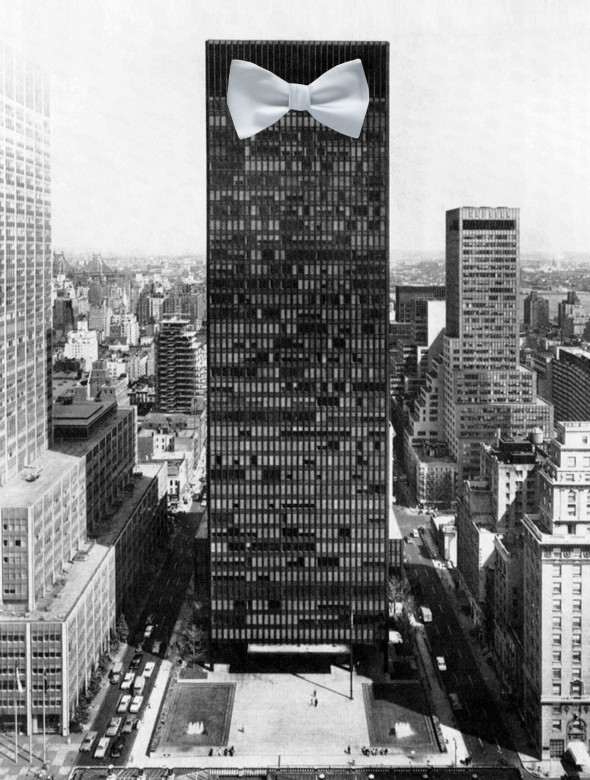 Fig. 5 Formal architecture
Fig. 5 Formal architecture
V. Attachments
Can you choose 5 images, among all that you have shared until now, that are particularly relevant to you?
Fig. 1 – The 9 Square Grid is a such a trope in architectural education. This project aims to design a 9 Square Grid from parts and fragments of plans on Archive of Affinities. If one adds and aggregates enough floor plans together the result is a proposal that oscillates between a small work of urbanism and a large work of architecture with the aim of a new type of collective and common space.
Fig. 2 – Plan for a porch 005 (homage to Durand) takes J.N.L Durand’s catalog of porches from 1802 and rather than looking at this collection as individual projects to be compared and contrasted, it looks at Durand’s porches as a collection that is to be assembled. As architects, we take on the issue of precedent as being something that is sacred. For me, precedent is not precious or an object to be revered, but rather something that is to be used, altered, and manipulated into something new that simultaneously references the original precedent but also moves away from it.
Fig. 3 – Elevation for a slab is a project that takes fragments and parts from discarded elevations posted on Archive of Affinities and recasts them into a new proposal for architecture. Elevations are scaled, cut up and added through a logic of formal contiguity.
Fig. 4 – Proposal for an office building is made up of parts of generic buildings that is recomposed through stacking and piling into a proposal for generic architecture. The ambition is too look at the generic as a mode of dumb and raw formalism.
Fig. 5 – Architecture is such a conservative field. Perhaps the best way to loosen it up might very well be to add a bow tie to it. In Formal Architecture an everyday object is made colossal as a proposed addition and accessory to the iconic Seagram Building.
… Grazie!
Related Posts
3 risposte a “Beyond blogging | Archive of Affinities”
Lascia un commento Annulla risposta
Questo sito usa Akismet per ridurre lo spam. Scopri come i tuoi dati vengono elaborati.

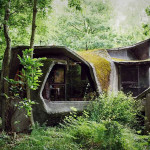

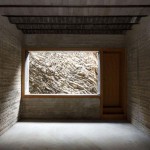




[…] también en ezines de potente carga gráfica, sino directamente visuales, y que en palabras de Davide T. Ferrando tienen el gran mérito de aportar referencias arquitectónicas a menudo inéditas, útiles tanto […]
[…] radomes. 1970s beach futurism. Little-known and long-demolished Mies buildings. As he put it in this interview, “Effectively, I am looking for projects that exist on the sidelines of the discipline of […]
[…] http://www.o-k-o-k.net https://www.instagram.com/archiveofaffinities/ http://archiveofaffinities.tumblr.com interview with Andrew >>> http://www.zeroundicipiu.it/2014/05/12/beyond-blogging-archive-of-affinities/ […]